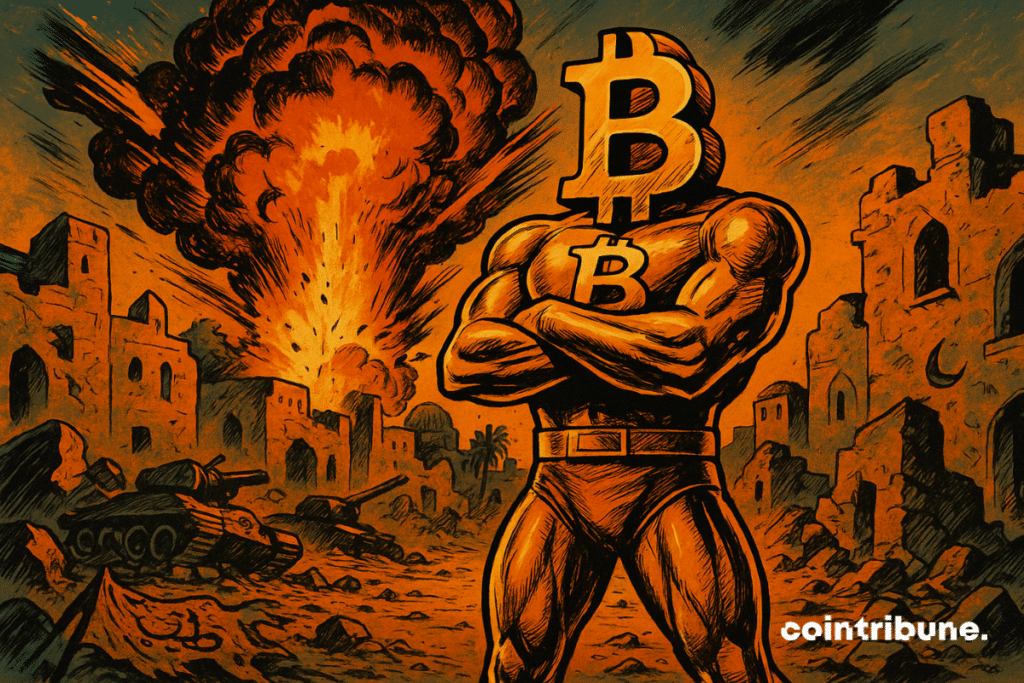Bitcoin Falls Below $99K, Then Surges Past $102K
While a US strike targeting Iranian nuclear sites raised fears of a regional escalation, bitcoin briefly fell below $99,000 before making a sharp rebound. In less than 24 hours, the asset erased its losses, defying the usual panic logic. This sequence indicates a strategic shift : bitcoin is no longer just a speculative asset, it is becoming an indicator of resilience in the face of geopolitical shocks.

In Brief
- The United States launched a large-scale military operation in Iran, targeting three strategic nuclear sites.
- Bitcoin plunged sharply below $99,000 just after the announcement of the attack, a level unseen for 46 days.
- Oil fell by more than 5 %, a paradoxical move amid a geopolitical crisis.
- Bitcoin quickly rebounded above $102,000, driven by opportunistic buying from institutional players.
Targeted Strikes and Immediate Volatility
On Saturday night, the United States launched a large-scale military operation called “Midnight Hammer”, targeting three strategic Iranian nuclear facilities. These bombings caused the collapse of the crypto queen’s price. According to the Pentagon, it was “the largest operational B-2 strike in American history.”
In total, 125 aircraft, including seven B-2 stealth bombers, took off from Whiteman Air Force Base in Missouri. The bombers dropped 13,600 kg bombs on the Fordo and Natanz sites, while a US submarine targeted Isfahan with several Tomahawk missiles.
This coordinated attack immediately pushed the bitcoin price below the symbolic $99,000 mark, a first in 46 days.
Here are the main highlights of this sequence :
- Three Iranian nuclear sites targeted : Fordo, Natanz, Isfahan ;
- 125 aircraft involved, including 7 B-2 Stealth Bombers ;
- Bombings with “bunker buster” bombs ;
- More than two dozen Tomahawk missiles fired from a submarine ;
- The immediate drop in bitcoin : falling back below $99,000, with a low of $98,286.21.
The next day, Iran threatened to close the Strait of Hormuz, through which about 30 % of the world’s seaborne oil passes. This declaration heightened market tension. US President Donald Trump immediately responded via his social network, warning that “any retaliatory attempt will be met with an overwhelming response.”
This verbal escalation, coupled with sharp price movements in risk assets, put investors on alert. Early signs of panic were seen in liquidations of derivatives products, with a clear imbalance against short positions.
Bitcoin Resists, Oil Drops : A Market in Transition?
On Monday morning, as tensions remained palpable in the Middle East, bitcoin reversed its trend. The crypto regained more than 3 % within a few hours, reaching $102,916. This rebound occurred even as oil prices fell counterintuitively. The WTI barrel dipped below $70, and Brent settled at $77.01.
The Strait of Hormuz remains open, raising questions about the stark dissonance between the severity of the geopolitical situation and the reaction of the oil market. This unusual price decline during a crisis contrasts with renewed interest in bitcoin, fueled by strategic buying.
The company Metaplanet, for example, took advantage of the dip to accumulate BTC.
Anthony Pompliano announced the creation of Procap, a bitcoin treasury company with a capital of one billion dollars.
Meanwhile, the altcoin market suffered a much sharper decline, amplifying BTC’s relative dominance. Cryptos like Ethereum (-9 %), Solana (-8.5 %), and Aptos (-14 %) dropped heavily.
Liquidations reached $876.41 million, including $777.91 million on long positions, revealing extreme tension in market expectations. This dynamic raises the question of a possible repositioning of investors towards bitcoin as a relative safe haven in an unstable environment. However, the overall volume decline (-10 % over 24 hours) suggests ongoing caution.
As attention remains focused on a possible military escalation and on Iran’s strategic decisions regarding the Strait of Hormuz, this sequence could mark a turning point for bitcoin’s perception. If it confirms its resilience in a climate of major geopolitical tension, it could move even closer to safe haven asset status, less volatile than the Nasdaq and the S&P 500, in the eyes of institutional investors.
Maximize your Cointribune experience with our "Read to Earn" program! For every article you read, earn points and access exclusive rewards. Sign up now and start earning benefits.
Diplômé de Sciences Po Toulouse et titulaire d'une certification consultant blockchain délivrée par Alyra, j'ai rejoint l'aventure Cointribune en 2019. Convaincu du potentiel de la blockchain pour transformer de nombreux secteurs de l'économie, j'ai pris l'engagement de sensibiliser et d'informer le grand public sur cet écosystème en constante évolution. Mon objectif est de permettre à chacun de mieux comprendre la blockchain et de saisir les opportunités qu'elle offre. Je m'efforce chaque jour de fournir une analyse objective de l'actualité, de décrypter les tendances du marché, de relayer les dernières innovations technologiques et de mettre en perspective les enjeux économiques et sociétaux de cette révolution en marche.
The views, thoughts, and opinions expressed in this article belong solely to the author, and should not be taken as investment advice. Do your own research before taking any investment decisions.